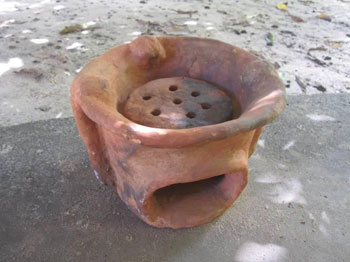No Flay: Improved Clay Brick Cookstove
Evolution
|
MENU |
The name ‘Noflay’ is an expression common in the Gambia and Senegal, understood across many local dialects as ‘convenience’, ‘easy’ or ‘no problem’. The overall objective in designing the Noflay stove was to create a low priced stove made from local materials that could reduce fuelwood consumption and indoor air pollution while also improving cooking convenience and safety. The Noflay is a culmination of an evolving improved clay stove design that has built upon previous research and field experimentation by REAP-Canada and their local development partners.
 Hand Molded Fired Stove |
 24 Brick Stove |
 First prototype of Noflay Stove Design |
 Combustion chamber |
REAP’s first attempt to introduce an improved wood stove in West Africa was through the introduction of bucket rocket stoves (2005-2010) which were well received but proved expensive to produce, were undersized for the heat demand of most households and had poor longevity. Then, in 2010, a hand molded clay fired stove was tested but was found to be undersized and prone to breakage. A logical evolution to improve stove longevity appeared to be to use fired clay bricks. So 16-brick and 24-brick rocket stoves (fired bricks with cement mortar) were tested several villages and proved resilient. However, a central problem was the constant outward pressure on the walls caused by heavy cooking pots which eventually caused the outside walls to collapse. Furthermore, these stoves appeared to suffer from excess air as the square shaped combustion chamber allowed easy passage around the round cooking vessel into the corners. So, while the 24-brick stove was resilient, there were improvements to be made in its combustion emissions and heat transfer. After researching superior design features of stoves like the Esperanza and Lion stoves, two main features were incorporated into an improved brick stove design: 1) An improved combustion chamber that could also act as a pot support; and 2) A round shroud of bricks for the outer wall that would help reduce excess air, improve heat transfer, reduce heat loss, and improve safety from accidental fire.
The first prototype of the Noflay was built in the NATC kitchen in The Gambia in September 2011. The stove was brick intensive as it used large bricks and was built for a commercial cooking pot. However, the performance of the stove appeared to be excellent and the design was well understood and appreciated by local villagers who saw it in operation.
Subsequent prototypes of the Noflay were built in early February 2012 using hand sawn “green clay” or wet unfired bricks and several efforts were made to create custom bricks of various sizes to build the combustion chamber and shroud of the stove. In the end the design that evolved reduced the number of bricks in the top two rows to provide a desired gap between the wall and the cooking pot while also allowing the bottom bricks to have an air gap from the combustion chamber to enable preheating of air. Four entry points for primary air were established and the main entry point was the front fuel loading door. It was designed to use moderately sized fuel wood to minimize cold air entry and prevent excess air problems. The remaining three primary air entry points were placed behind one of the three centre combustion chamber bricks to force air to travel around the bricks and warm prior to entry into the central combustion chamber. The central combustion chamber was built to a height of approximately 20cm to enable the flames to develop sufficiently within the refractory chamber. The secondary air holes were put around the 4th layer of bricks to promote further gas burning and to help air mixing. A fire viewing window was put into the 5th layer to help improve user convenience to manage the fire.
Summary of improved stove design features introduced into the Noflay:
- Reduced excess air: with smaller entry points for primary air and making a round shroud that is adjusted to fit to local pot size (the pot plugs the hole that creates excess drafts in most stoves)
- Primary air restricted & diversified: 3 of the 4 entry points aren’t aligned with the combustion chamber
- Preheated air: cool outside air is drawn in and along the narrow gap between the inner combustion chamber and outside walls where it preheats
- High temperature combustion: the central combustion chamber has preheated air and a defined combustion chamber with 20cm brick walls that radiate back heat.
- Secondary air: the stove is equipped with 4 entry points for secondary air in the 4th layer of bricks
- Improved heat transfer: the central combustion chamber directs hot flames under the pot and then allows them to pass through the narrow gap along the outside of the pot and the outer wall. The shroud also protects the pot from cooling wind.
- Stove safety: the ‘No-Fly’ is amongst the world’s safest stoves. It protects the home from fire with its outer wall and protects infants from falling or crawling onto the fire. There is no risk of an adult or child knocking over a boiling pot.
- Cleanliness: the stove has reduced smoke emissions and keeps ash confined in the central combustion chamber; it is also easy to clean.
- Convenience: the exposed central combustion chamber allows an easy start to the fire and the fire viewing window makes it easy to maintain. It operates as simply as a 3 stone fire but it is more convenient as both fire starting and boiling are fast and it is relatively effortless to simmer.
- Minimized material consumption: Stove built largely of local natural materials and custom brick designed round shape minimizes both resource consumption and costs for production and transport.
 NoFlay Stove |
Learn more about:




